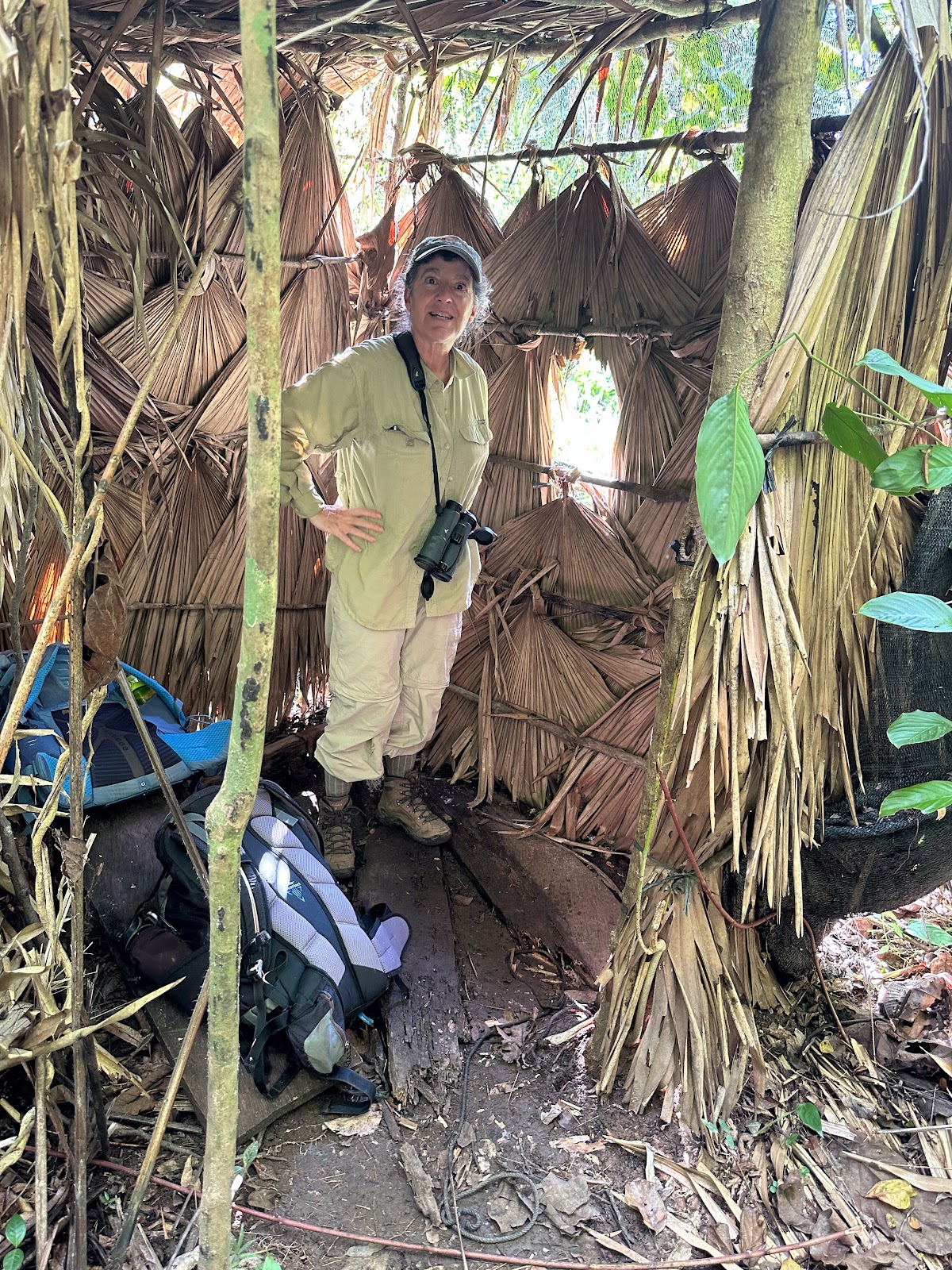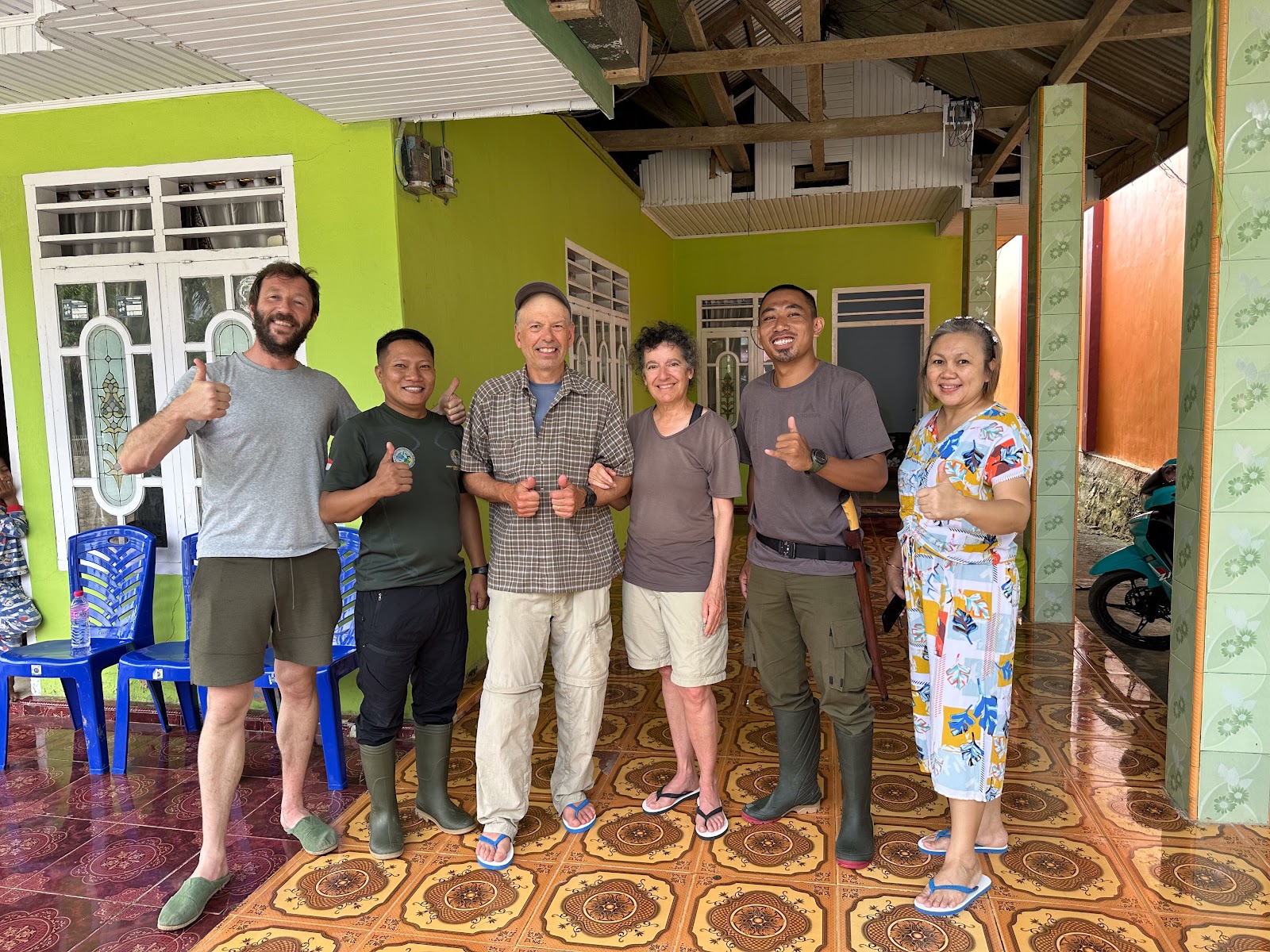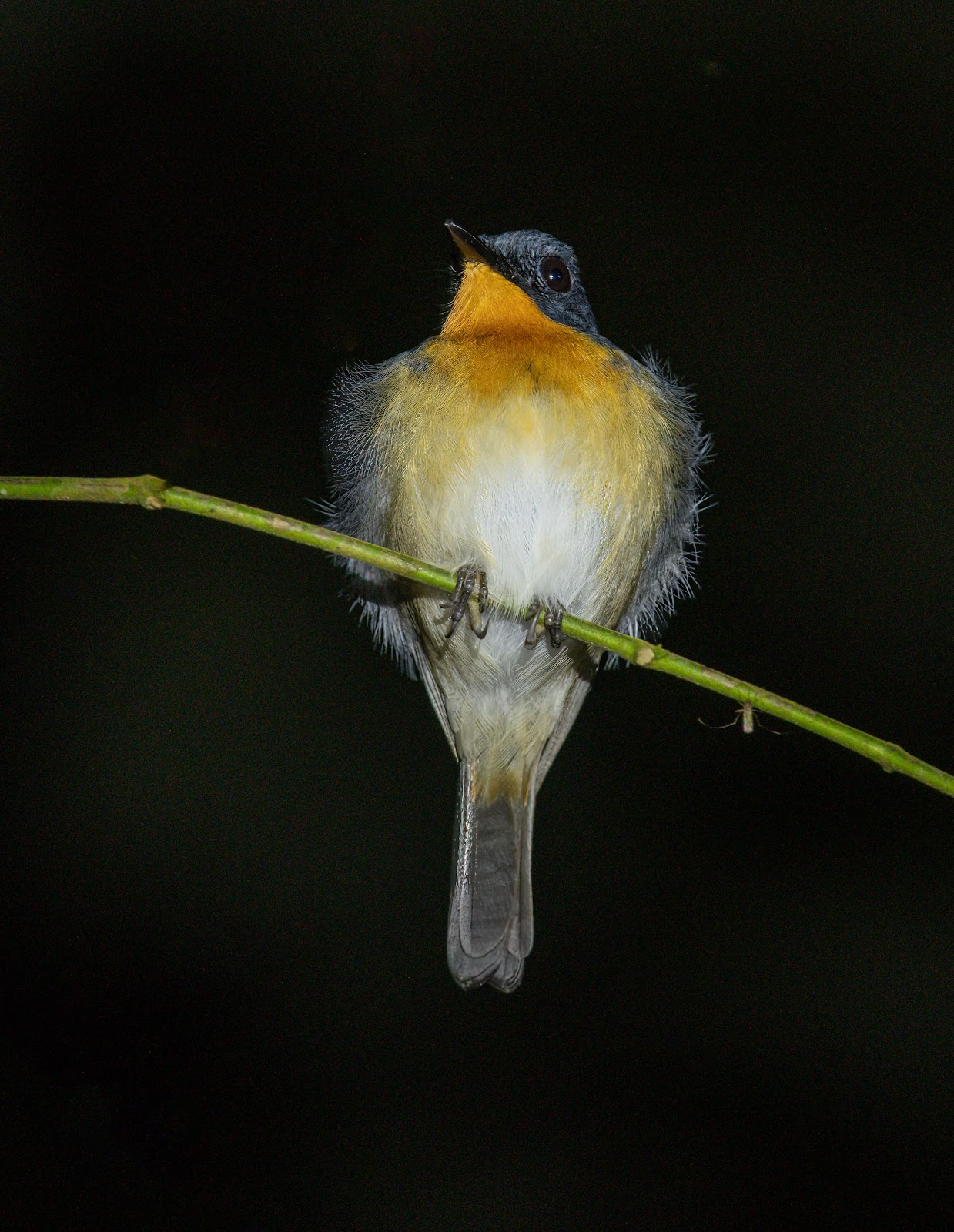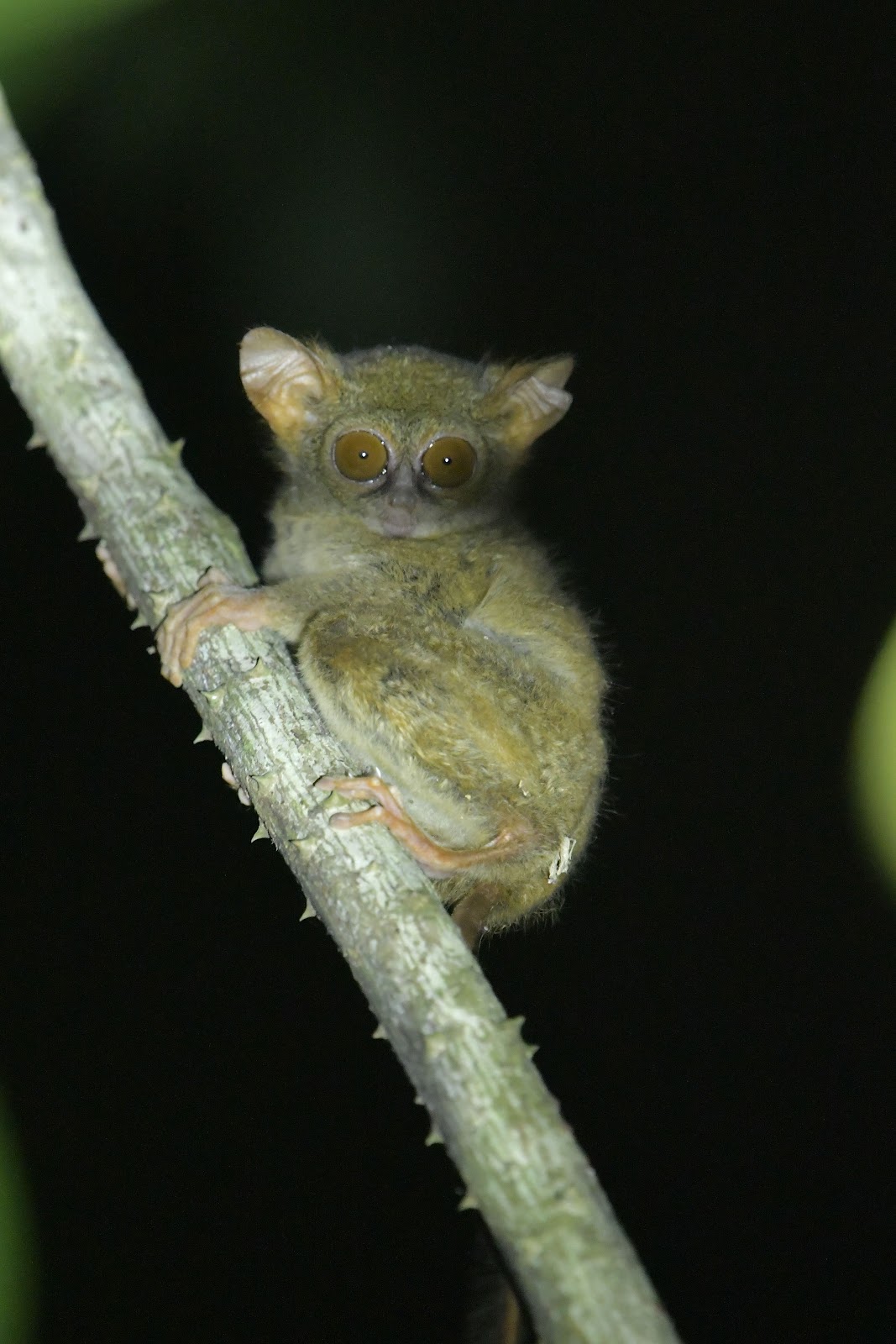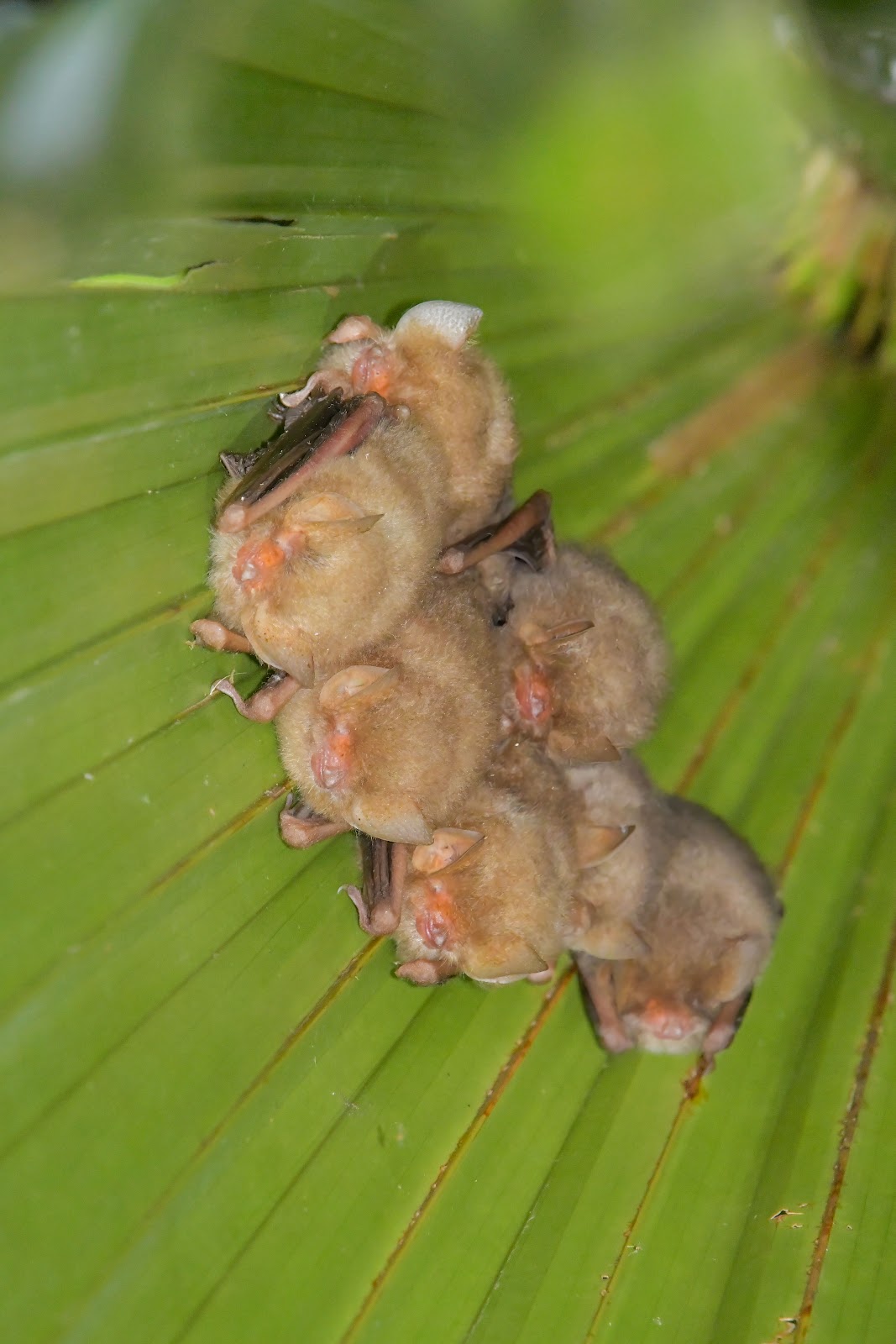The next leg of our Indonesian odyssey has brought us to West Papua, the Indonesian part of the second-largest island in the world, New Guinea. We flew from Sorong to Manokwari, where we met up with the rest of our group on a trip arranged and escorted by Martin Royle of Royle Safaris and still guided by Carlos Bocos. We departed the hotel at 3:00 am the following morning for the 1-hour drive to Mupi Beach. Here we met our porters who would carry our duffels, food, and other essentials to Mupi Village. We set off around 4:30 am in the darkness with our headlamps lighting the way. The trail soon became very steep, muddy, and slippery. It was slow going, but after climbing 2000 feet, the grade had leveled out, and it was now light.
 |
| Hiking Up to Mupi |
In 4 and a half hours, we reached the Teu River. To my dismay, we had to cross the raging river on a slippery fallen tree trunk with some rickety handrails! The porters attempted to repair the railings, but I was ready to turn back!
 |
| 1st Log Bridge |
To add insult to injury, there were leeches! Marc had already been leeched and his sock was a bloody mess. There was no way I was going to cross the log bridge standing. The only safe way was to straddle it and scooch across. Surprisingly, the others agreed with my plan of attack, and we all safely scooched across while the porters crossed barefoot with heavy loads. We took a break on the other side, where Hans, our local guide, broke the news that there were three more log bridges to cross! Thankfully, they were much easier. The tree trunks were wider and drier, so it was safe to walk across.
 |
| Last Log Bridge |
We made the last river crossing in 6 hours and stopped for another break. Here we spotted our first mammal, a Javan Rusa Deer. We still had another 2000 feet of straight-up climbing to do. Thankfully, the villagers had built handrails along the steepest sections. Marc and I were struggling with our heavy packs, and Carlos carried Marc’s, while Marc took mine. We were now following two women porters. If they could make the climb barefoot with heavy loads, so could I with no load and sturdy hiking boots! Carlos said we were nearly there, but it seemed to take forever. We finally reached Mupi Village at 1:40 pm, 9 hours and 15 minutes after we had set off!
 |
| Village of Mupi |
The village was small, consisting of 2 houses, a church, 2 kitchen buildings, and 2 outhouses. The villagers had taken one house, and we had the other. There were 3 separate rooms, and we were assigned one. I was curious about the church and went to check it out. It was basically one large open room with a pulpit and red plastic chairs piled in two corners. It was clean, and two sleeping pads had been laid on the floor, so we opted to stay in the church. We’d have plenty of room and privacy. We were served a late lunch/early dinner before setting up our extra sleeping pads and liners to take a quick nap before our first night walk.
 |
| Our Mupi Accommodation |
We left the village at 7:30 and headed back down the main trail. We spotted our first cuscus, a Northern Common Cuscus. These nocturnal marsupials inhabit northern New Guinea and have been introduced on surrounding islands. This individual was a gray morph and was perfectly adapted to an arboreal lifestyle, feeding on leaves, fruit, and bark. A second Northern Common Cuscus, a stunning white morph, was found.
 |
| Northern Common Cuscus |
The third cuscus we encountered was a different species, a Ground Cuscus, even though it was in a tree. The Ground Cuscus differs from all other cuscus in spending days in burrows in the ground and appears as comfortable at ground level as in the trees.
 |
| Ground Cuscus |
An hour and 45 minutes later, we returned to a quiet Mupi as all the villagers had gone to bed. We turned in after a very grueling but successful day. We had made it to Mupi Village and found our first mammals!
The villagers woke us up early with their loud chatter, so we got up and watched a bird feeder with pandanus fruit set up nearby. Both Superb and Magnificent Bird-of-Paradise visited. Flocks of Fairy Lorikeets and a Pesquet’s Parrot flew overhead. A bird hide had been set up in the forest about 100 meters away, from which we saw Black Sicklebill, Fan-tailed Berrypecker, Western Parotia, Magnificent Riflebird, and Magnificent Bird-of-Paradise.
 |
| Magnificent Riflebird |
That afternoon, I tried taking a nap, but when I looked up from my sleeping pad, I could see what appeared to be a snake coiled up on one of the rafters. A look with my bins confirmed it was a snake! We asked the villagers to remove it, but they came armed with a machete and were intent on killing it. The last thing I wanted was snake guts and blood on my things, so we told them we’d wait for Carlos. When he returned, he used a stick to lift the snake from the rafters. The villagers were terrified and ran around shrieking. I later identified the snake as a Brown Tree Snake, which is only mildly venomous. Although native here, this snake was accidentally introduced to Guam after World War II and is now infamous for being an invasive species responsible for extirpating the majority of the native bird population.
 |
| Brown Tree Snake |
Tonight’s night walk was on a steep, slippery trail with a side slope behind the village. The terrain was difficult, and Marc and I got leeched, soaking our socks and pants with blood! The exertion was worth it as we picked up three new mammal species in addition to the two cuscus species we found last night. The Striped Possum was hidden in vegetation and difficult to see. This nocturnal marsupial is native to New Guinea and Queensland, Australia. It’s unusual in that it has an elongated fourth digit, which it uses to extract insects detected by percussive foraging from under the tree bark. Only three species of mammals are known to use this method of foraging and are sometimes referred to as “mammalian woodpeckers”.
 |
| Striped Possum |
We had better luck with finding and viewing a Reclusive Ringtail. Another nocturnal marsupial, this possum is endemic to the Arfak Mountains here in the Vogelkop Peninsula of West Papua!
 |
| Reclusive Ringtail |
The third new mammalian species was a Chestnut Tree Mouse. We spotted two, but only one paused long enough for a photo.
 |
| Chestnut Tree Mouse |
Fortunately, there was no church service the following morning, and we slept in until 6:30. We went to the creek to wash our bloody clothes and had just finished when we got the call that a Grizzled Tree Kangaroo had been found by the villagers! We rushed back to the church and grabbed a few things before heading off into the forest. It was tough going bushwhacking up and down steep slopes. I wanted to give up and asked Hans how much further. He replied 30 minutes, so we pressed on. Thirty minutes later, I asked Hans how much further, and he replied 25 minutes! I really wanted to give up, but we were so close. We could hear the villagers hooting and hollering at the site. It was one more steep climb down and then straight up before we reached the site, two and a half hours after setting off! A female Grizzled Tree Kangaroo was on top of a tree about 50 meters away. Supposedly, she had a joey, but we never saw it. The Grizzled Tree Kangaroo is an uncommon marsupial native to western and northern New Guinea. They spend most of their time in the trees feeding on leaves, fruit, and bark.
 |
| Grizzled Tree Kangaroo |
Now for the arduous return trip. Thankfully, another villager helped me on the steep sections, and he cut a trail with his machete along the way. We got back to Mupi very tired but ecstatic that we had seen a Grizzled Tree Kangaroo, one of the prime targets for our trip. Early the next morning, the village kids showed up with a baby Müller’s Three-striped Dasyure. Not much is known about these carnivorous marsupials found only in western and northern New Guinea. It was terrifying to be carried around by the tail, and we convinced the kids to let it go on a tree so we could get some photos of it in a more natural setting.
 |
| Müller’s Three-striped Dasyure |
Later in the morning, the call came in that a Vogelkop Tree Kangaroo had been located! It only took 2 hours and a climb of 1000 feet to reach the site. The tree kangaroo was about 50 feet up a tree and peered down at us. The Vogelkop Tree Kangaroo is endemic to this part of New Guinea and spends most of its time in the trees feeding on leaves and fruit. Another prime target viewed and photographed!
 |
| Photographing a Tree Kangaroo (Photo by Hans) |
 |
| Vogelkop Tree Kangaroo |
Back at Mupi, we were served an early dinner and rested up before going on a night walk. It was very quiet mammal-wise, and we only saw 2 species: a Common Blossom Bat and a Northern Common Cuscus. The following day, we hung out in Mupi Village trying to recover from 4 arduous days in the Arfaks and prepare for another night walk. It was eerily quiet for the first two hours. We hadn’t seen a single mammal except for a bat or two. Right after we decided to turn back, Carlos spotted a possum high up in a tree. It was an Arfak Ringtail, a new mammal for us! Little is known about this species, which is restricted to the Arfak Mountains in the Vogelkop Peninsula.
 |
| Arfak Ringtail |
Soon after, we spotted three Northern Common Cuscus. Two were feeding in the same fig trees as on a previous night. We took the “easier” way down, encountering Moluccan Naked-backed Fruit Bats and a Common Blossom Bat.
 |
| Moluccan Naked-backed Fruit Bat |
We spent a leisurely final day in Mupi in preparation for the long trek out the following morning. Marc and I opted to do a shorter night walk around the village and went to the bird hide to see if there were any nocturnal mammals feeding on the fruit. There were none, so we headed back, spotting some eyeshine on the way. At first, I thought the reflection was from a spider because it was so small and dim, but it turned out to be a Reclusive Ringtail!
 |
| Reclusive Ringtail |
I didn’t sleep well the last night in Mupi. A brief rain shower had me worried that we’d have to hike down in the pouring rain. I heard thunder in the distance and saw a flash of lightning, but thankfully no more rain. After 6 nights, we were leaving Gunung Mupi and took a group photo before setting off just before 7:00.
The steep hour-long descent down to the river wasn’t too difficult thanks to the wooden railings the villagers built for us. The first three fallen tree trunk bridges were straightforward, and we crossed them easily. We reached the last log bridge and straddled it as we had done on the way in. It was up and down over several small ridges before we climbed out of the river drainage for good. Whew, the hard part was over, or so I thought, but we still had another 2000 feet to descend! Marc and I were struggling on the steep, slippery sections, but Hans was there to offer a helping hand. It was a grueling two hours back to the trailhead where our vehicles and the villagers were waiting. Marc and I climbed into the back of the van with a few of the porters for the drive back to Manokwari.
 |
| Driving Back to Manokwari. |
Back at the hotel, we were rewarded with a warm shower and a comfy bed! Although our visit to Gunung Mupi was physically challenging and the accommodation a bit on the rustic side, we are so grateful to Julius and the villagers of Mupi for sharing their home and wildlife with us! It was a privilege to see so many endemic marsupials that we hadn’t even heard of before this trip. A big thank you to Hans and Carlos for getting us safely up and down the mountain and for finding us so many wondrous creatures! On to the next leg of our Indonesian odyssey, where more amazing animals await!
We hope all is well with everyone,
Marc and Peggy
Our route map:
Gunung Mupi Mammal List: May 24 - 30, 2024
| No. | Species | Scientific Name | Comments |
| 1 | Javan Deer | Rusa timorensis | introduced |
| 2 | Northern Common Cuscus | Phalanger orientalis | |
| 3 | Ground Cuscus | Phalanger gymnotis | |
| 4 | Striped Possum | Dactylopsila trivirgata | |
| 5 | Reclusive Ringtail | Pseudochirops coronatus | endemic |
| 6 | Chestnut Tree Mouse | Pogonomys macrourus | |
| 7 | Grizzled Tree Kangaroo | Dendrolagus inustus | |
| 8 | Vogelkop Tree Kangaroo | Dendrolagus ursinu | endemic |
| 9 | Müller’s Three-striped Dasyure | Myoictis melas | |
| 10 | Common Blossom Bat | Syconycteris australis | |
| 11 | Moluccan Naked-backed Fruit Bat | Dobsonia moluccenis | |
| 12 | Arfak Ringtail | Pseudochirulus schlegeli | endemic |







